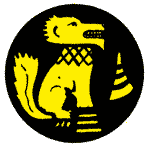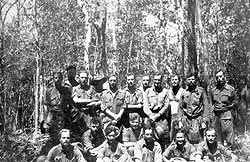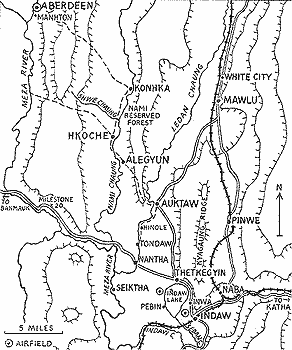2nd Queen's and the Chindits

 |
| 2nd Bn The Queen’s Royal Regiment The Officers of 22nd Column, The Chindits. (Click to enlarge) |
In 1943 Field Marshal Lord Wavell, then Commander-in-Chief India and soon to become Viceroy, was convinced that the Japanese had stretched out too far and should be hit before they had time to consolidate and invade India. In March the Battle of the Boxes in the Arakan and in May the defence of Kohima had shown that they could be beaten. 77th Indian Infantry Brigade, directed by Major-General Orde Wingate who had been a successful guerilla leader in Abyssinia, had successfully penetrated the Japanese positions in central Burma and achieved limited objectives to disrupt the enemy’s communications system before being withdrawn. But much needed to be done in India to build up the resources for a full scale offensive to retake Burma. The United States General Stillwell’s Chinese force was engaging the enemy in the north of Burma and it was decided to insert a British force behind the Japanese in the centre.
70th Division was to be the main part of this force. General Wingate was to be in overall command. 16th Brigade was to infiltrate through the mountainous jungle country and secure airstrips where the three other brigades of the division would be flown in and landed by gliders and Dakota aircraft. The brigade was formed into eight columns two of which consisted of 2nd Queen’s, No 21 column commanded by Lieutenant Colonel Metcalfe and No 22 commanded by the Second-in-Command, Major T.V. Close. Each column consisted of 400 men, 75 mules and 12 ponies, the latter mainly for carrying casualties. The columns were to be re-supplied by airdrop every five days. Each man carried five day’s ‘K’ rations, weapons, ammunition, wirelesses and other equipment which even included a ‘Mae West’ for crossing the River Chindwin. Individual loads weighed some 65 pounds.
After crossing the Indian frontier the two columns spent 94 days in Burma of which 67 were spent on the march, usually in single file. The total distance covered was 575 miles. The highest point reached was 5,700 feet. Sixteen airdrops were received and six airstrips were constructed.
 |
| (Click to enlarge) |
Major Close has described the expedition:
“We arrived at Ledo, Assam, in the extreme north-east tip of India on 23rd January after about a week in the train. Ledo was the base for General Stilwell’s operations with his American trained and equipped Chinese. Our projected operation was most secret; this entailed de-training in the middle of the night and hiding ourselves in the thickest, wettest and most leech-ridden jungle imaginable. Here we sat doing nothing in the rain for several days while the Brigade concentrated. The mules with their leaders were meanwhile despatched down the famous Ledo road, under construction by American engineers. They had a miserable walk for some seventy miles, in ten to twenty inches of mud. The remainder of us were lucky to do the journey in an American convoy of huge lorries driven by Chinese. Driving the Ledo Road would be alarming with the best drivers in the world. With those Chinese it was an experience few will forget. The road was a jagged scar torn through dense jungle; hairpin bends over mountain ranges up to 5,000 feet, descents to semi-constructed bridges over roaring torrents, and bulldozers and American negroes working everywhere, were an unforgettable sight.
Arrived at the spot where we were to leave the road, we again sat in the rain for some days while final concentration took place. Little was known of the track we were to follow, although one American was supposed to have passed that way a year before, and reported on it as impassable for a brigade. It certainly looked it from the map.
A Brigade Advance Party was on ahead doing what work it could to improve the track, and the Queen’s behind them led the Brigade. Probably no Brigade had ever marched some 350 miles in single file, and I hope none will ever have to do so again. This, however, was forced on us by the nature of the country.
Our first obstacle, encountered the day we left, was a hill two thousand feet high, with an average grade of one in two, and frequent relapses to one in one. A formidable barrier, it took us two days of sweat and toil in pouring rain to get the mules across - we hoped we shouldn’t meet many like it.
Impossible to describe the march in any detail; days of sheer heartbreaking slog. Off-loading mules and manhandling 80 lb loads up slippery tracks too steep almost to walk up oneself without using one’s hands. Water shortage in pouring rain with a mountain stream inaccessible three thousand feet below, so water was dropped from the air in containers; worries over food; supply drops taken in impossible places and watching the others drop several thousand feet into the jungle below.
The rain was torrential and continuous; the gradients were often one in two. No single stretch of level going a hundred yards in length existed. Many mule loads had to be carried by hand up steep slopes. The cold was intense, particularly at bivouac over five thousand feet. The 70 pounds. the men were carrying was greatly increased in weight due to saturation with water. Leeches, which were innumerable, were the least trying of the conditions: supply dropping was on the whole atrocious, 50 per cent falling thousands of feet down the cliffs and becoming a dead loss. Columns averaged nine days to cover thirty-five miles.
At last, on 29th February, we reached the Chindwin. As we marched the last few hundred yards to the river bank, Dakotas towing gliders full of river crossing equipment roared overhead. The Chindwin here was perhaps 300 yards wide with a very swift current. Assault boats with outboard motors were of enormous assistance: though, being almost as temperamental as mules, ten of the twelve were generally floating helplessly downstream. Every device was used to get the mules, loads and men rapidly across. Soldiers who could swim, swam; well-behaved mules swam free; others were towed behind the boats.
After some three weeks further marching, now through easier country, we arrived at Mahnton, two day’s march from our objective, Indaw, and established our stronghold and operational base, known as Aberdeen. Here the two column commanders received their orders. The Brigade objective was the capture of Indaw, thirty miles away, an important communication centre and base, with its two airfields. 21st Column were to sweep right round the south of Indaw, and come in on the objective from there. 22nd Column were to block the Indaw-Banmauk road, to prevent Indaw garrison being reinforced from the west. The two column commanders rode back on their ponies the three miles from Brigade H.Q.; it was a peaceful evening and hard to believe we were now in the middle of Jap-occupied Burma. We were sorry that the two columns were not to go into battle together as a battalion”.
There were strong arguments for resting the columns after their two months’ marches. They were tired; malaria, despite mepacrine tablets, had attacked a number of men, and many mules had developed sores from rubbing loads. Moreover two of the eight columns in the Force had been diverted to another objective. But every delay in launching an offensive decreased its chances of surprise, and there was news of Japanese reinforcements marching up the railway from the south, so the Force Commander decided to attack Indaw and its airfield without delay.
The Queen’s columns left Aberdeen on the 21st and 22nd March and during the next three weeks were involved in a number of encounters with the enemy including several highly successful ambushes and the discovery of a large ammunition dump hidden in the jungle which was destroyed by air attack. They returned to Aberdeen for three days rest in mid-April. By then a permanent garrison of Nigerians had been flown in and had wired the perimeter and dug strong defences. Meanwhile the Japanese offensive against Imphal and Kohima had started and no more troops, or the aircraft to supply them, could be spared to reinforce the Chindits. It was therefore decided to limit their objective to the capture and destruction of Indaw West airfield by the 16th Brigade with the Queen’s columns, now united, attacking from the west and two gunner columns from the north.
The airfield was overrun without resistance on the 24th and the Brigade was then withdrawn to India. This involved the Queen’s in a further march to the Broadway base fifty miles to the north-east on the far side of steep 3,000 foot hills in extremely hot weather, which took seven days. Very tired and with increasing sickness from heat exhaustion, tick typhus, jungle sores and malaria, they were glad to be flown back to Comilla in India in early May. They had come through a supreme test in conditions considered impossible for British troops in earlier days.
Related
